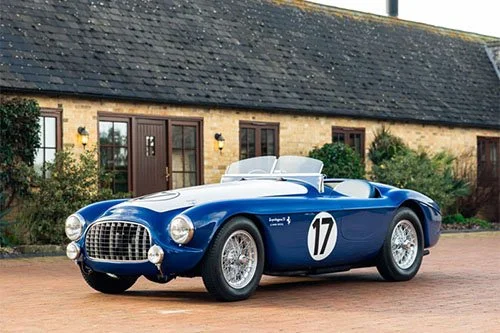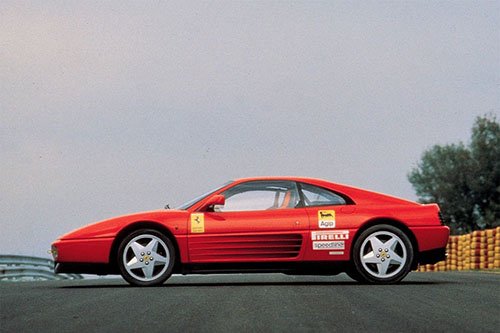Guide: Ferrari 550 Maranello & 550 Barchetta
Background
Although Auto Union’s famous Grand Prix cars of 1935 to 1939 had shied away from a convention front-engined layout, the mid-engined configuration adopted by these Ferdinand Porsche-designed behemoths did not become commonplace in Formula 1 until the late 1950s.
Sports Prototypes followed soon after and, by the end of the early 1970s, mid-engined layouts were the norm for many high performance cars where speed and handling were the overriding design characteristics.
Ferrari’s first production model to adopt a mid-mounted engine was the V6-powered Dino 206 GT of 1968. Five years later, the big Flat 12-engined 365 GT4 BB went into production. At this stage, it seemed likely that the front-engined layout had been consigned to history when it came to Ferrari’s out-and-out two-seat performance models.
In the years that followed, the BB was updated with a bigger and engine and fuel-injection. By 1984, it had morphed into the Testarossa. After the 1990s dawned, the Testarossa in turn became 512 TR and then the F512 M a couple of years later.
In 1996, against expectations and industry norms, Ferrari made the shock decision to switch back to a front-engined configuration for its two-seat production flagship. So ingrained was the mid-engined philosophy that many doubted the wisdom of returning to this more traditional configuration.
However, the new 550 Maranello instantly proved its doubters wrong; in the most clear cut demonstration of its performance capability, it lapped Ferrari’s Fiorano test track an astonishing three seconds faster than the outgoing F512 M.
The 550 Maranello was unveiled at the Nurburgring circuit in Germany in July 1996. On hand to pound the ten cars in attendance round the formidable Nordschleife were current Scuderia F1 drivers Michael Schumacher and Eddie Irvine plus the team’s test driver, Nicola Larini. Also present was 1979 World Champion, Jody Scheckter, three-time World Champion, Niki Lauda, factory 333 SP driver, Max Papis, and upcoming Italian F1 driver, Giancarlo Fisichella.
Chassis
The 550 Maranello was based around a traditional tubular chassis manufactured from high tensile welded steel. Designated Tipo F133 AB, it featured an extremely rigid central cell and a 2500mm wheelbase (100mm less than the four-seat 456 GT).
Suspension was via independent double wishbones with co-axial coil springs over gas-filled telescopic dampers and anti-roll bars at either end. Driver-operated electronically-controlled dampers offered a choice of Normal and Sport settings.
Servotronic speed sensitive power steering was fitted as standard along with four-channel ABS that integrated with a switchable traction control system.
Ventilated discs and four-piston light alloy calipers were fitted all round. The front discs had a 330mm diameter. Those at the rear measured 310mm.
The five-spoke magnesium alloy wheels were designed by Pininfarina and manufactured by Speedline. 18 x 8.5-inch rims were fitted up front and 18 x 10.5 at the rear. Michelin tyres were originally fitted. Track was 48mm wider at the front of the car for improved turn-in.
A 114-litre fuel tank was installed over the rear axle.
Engine / Gearbox
The Tipo F133 A engine fitted to the 550 Maranello was an updated version of the DOHC 5.5-litre 65° V12 used in the 456 GT. Most notably, this latest power unit came with redesigned cylinder heads and a variable length induction system.
Cast alloy was used to manufacture the cylinder block, four-valve heads, sump and sundry other castings. The alloy cylinder liners were treated with Nikasil to reduce heat and friction. Forged alloy pistons were sourced from Mahle and hooked up to titanium alloy connecting rods.
As per the 456 GT, dry-sump lubrication was employed. The compression ratio was hiked from 10.6:1 to 10.8:1.
Engine management was courtesy of the latest Bosch Motronic M5.2 system.
Variable back pressure exhausts were similar to those used by the F50.
Displacement was identical to the 456 GT: 5474cc thanks to a bore and stroke of 88mm and 75mm respectively. However, thanks to the various upgrades, peak output was substantially improved.
The 550 Maranello engine pumped out 485bhp at 7000rpm compared to 442bhp at 6250rpm.
The torque rating went from 406lb-ft at 4500rpm to 419lb-ft at 5000rpm.
The only gearbox offered was a rear-mounted six-speed manual. Transmission was through a single-plate clutch and limited-slip differential.
Bodywork
The 550’s Pininfarina-designed lightweight aluminium alloy bodywork was welded to the steel frame via a specially formulated sandwich material called Feran. The front and rear aprons were composite mouldings.
During the development stage, almost 5000 hours were spent in the wind tunnel. The result was an aggressive yet elegant creation with a low 0.33 CD value. It also incorporated advanced underbody aerodynamics. Downforce was developed consistently over both axles.
In a nod to some of the 550’s illustrious front-engined predecessors, Pininfarina incorporated GTO-style fender vents carved out from behind each front wheelarch and a 365 GTB/4 Daytona-inspired cut-off tail with two circular lights either side.
The air-piercing nose housed a wide grille aperture and integral front spoiler. Further up were high-intensity homofocal light clusters – the 550 Maranello was the first brand new series production Ferrari road car since 1968 not to feature retractable headlights.
A hood-mounted engine scoop boosted air pressure to the intake system to gain an extra 20bhp. On the left-hand rear fender was a solitary vent that forced cool air into the brake radiator.
Interior
Like the exterior, the 550’s interior was a major departure from the outgoing F512 M.
The curvaceous dash was a more organic shape and swept neatly around to merge with the centre console. Aside from the carpeted sections, Connolly leather was used to upholster practically every surface.
The instrument binnacle behind the three-spoke steering wheel was home to a large analogue rev counter and speedometer. Off to the sides were smaller read outs for water temperature and oil pressure.
An additional three gauges (oil temperature, fuel and a clock) were located in a separate central binnacle above a trio of circular vents. Underneath the vents were a bank of seven switches and the ventilation controls.
The centre console was home to the audio system, a traditional open gate gear shifter, an oddments tray, a few other switches and an ashtray.
Behind the seats was a large luggage platform complete with leather retaining straps.
Standard equipment included electric seats, twin airbags, air-conditioning, electric windows, electric mirrors, a high end audio system with CD player and drilled alloy pedals.
Overall, the 550 was much more practically packaged than its mid-engined forebears.
Options
Several optional extras were initially offered to include fitted luggage, coloured upholstery for the dash, door pillars, steering wheel and headliner, contrast seat piping, Daytona-style seat inserts, out-of-range paint / leather and Scuderia Ferrari wing shields.
Later on, Ferrari expanded the options list with two-tone leather, a cockpit fire extinguisher, Modular split rim wheels, coloured brake calipers, carbonfibre leather-covered Racing seats, Racing seats with fabric inserts, a choice of carbon fibre interior trim packs, a 250 GT-style quilted leather parcel shelf, four-point harnesses and a leather-covered roll bar. The harnesses and roll bar were not available in the USA.
There was also the desirable Fiorano Handling pack which comprised stiffer springs, uprated Pagid RS 4-4 brake pads, a thicker rear anti-roll bar, 10mm lower ride height, re-mapped steering and suspension software, adjusted toe-in and caster settings and red brake calipers.
Weight / Performance
At 1690kg, the 550 Maranello surprisingly weighed the same as a 456 GT.
It was, however, much faster. Top speed went from 186mph to 199mph. The 0-62mph time dropped from 5.2 seconds to just 4.4 seconds.
Moreover, perfect 50/50 weight distribution gave the new car exceptional handling and balance dynamics.
550 Maranello World Speed Record
On October 12th 1998, Ferrari took a 550 Maranello to the 12km oval at the Transportation Research Center in Marysville, Ohio. Here a series of world speed records were undertaken.
The car used (chassis 112957) was equipped with an array of special parts, several of which went on to feature as part of the Fiorano Handling pack. They included stiffer shock absorbers, helicoidal springs, re-mapped steering software, an infra-red tyre temperature control system, an OMP roll cage, Racing seats with four-point harnesses, an automatic fire extinguisher, rapid refuelling system and an additional electronic pump in case either the power steering or brake servo pumps failed.
The record attempt was tackled by journalists from Car and Driver (Csaba Csere) and Quattroruote (Duilio Truffo).
Csere and Truffi went on to secure production car world records for the highest average speed set over 100km (188.88mph) and 100 miles (183.95mph).
To celebrate the achievement, 33 commemorative replicas of the record setting cars were built between 1999 and 2000. Dubbed the 550 Maranello World Speed Record (or WSR), these cars were equipped with the Fiorano Handling pack, a leather trimmed roll cage, an alcantara steering wheel and Racing seats with four-point harnesses. The majority were completed in Grigio Titanio over a Bordeaux interior to match chassis 112957. Ten were right-hand drive.
550 Barchetta
At the Paris Motor Show in September 2000, Ferrari unveiled the limited edition 550 Barchetta Pininfaraina. Notionally created to celebrate Pininfarina’s 70th anniversary, the Barchetta appeared three months after Pininfarina’s own 550-based concept: the unique Rossa 2000.
Ferrari announced in Paris that 448 of the handsome new Barchettas would be manufactured. They were offered exclusively to existing customers and the entire run was pre-sold prior to the first production car rolling out of the factory.
As expected, it was the bodywork that saw the most radical alterations in the transition to Barchetta configuration.
The height of the windscreen was cut by 100mm to give a more Roadster-like appearance. The windscreen surround was redesigned and incorporated a high-strength steel tube that was able to withstand the car’s weight in the event of a roll. The lower section of the A-pillars was body coloured.
Behind each seat was a roll-over bar lined with impact-absorbing material and trimmed in leather. These provided enhanced structural rigidity as well as protection for the occupants in the event of an accident.
With the exception of streamlined elements behind the head rests and roll over bars, the rear deck was largely flattened.
A flimsy manually operated canvas hood was supplied but only recommended for emergency use.
Another special feature was a natural aluminium fuel filler cap on the right-hand rear fender.
Scuderia Ferrari wing shields and the two-piece split rim Speedline alloy wheels were fitted as standard.
Inside, normally optional equipment such as Racing seats and carbonfibre inserts were fitted as standard. There was also a numbered plaque signed by Sergio Pininfarina at the back of the centre console.
550 Barchettas delivered in Europe were supplied with a pair of Ferrari-branded helmets.
Despite its strengthened chassis, the lack of a conventional soft top meant weight was kept at 1690kg. Similarly, the 0-62mph was 4.3 seconds. However, as a result of the messier aerodynamics, top speed dropped from 199mph to 185mph.
550 Barchetta Speciale
Chassis 123652 was one of the circa twelve pre-production Barchetta prototypes. It was built with a number of special features for Scuderia Ferrari General Manager, Jean Todt.
Painted Argento with Bordeaux upholstery, 123652 came with headlight surrounds and the instrument binnacle from Ferrari’s soon-to-be-released 575M. Racing seats were embossed with Michael Schumacher’s ‘MS’ script, a signed Pininfarina plaque was fitted on the centre console and Schumacher’s signature also featured between the roll bars.
End of Production
Ferrari’s return to a front-engined configuration for its flagship two-seat production model proved a critical and commercial success. The 550 Maranello sold strongly throughout its life and was subsequently replaced by the revamped 575M.
The markedly less attractive 575M most notably heralded the arrival of Magnetti Marelli’s F1 paddle shift transmission for the first time on a V12 Ferrari.
550 production was discontinued in December 2001.
By this time, Ferrari had completed 3083 examples of the fixed-head Maranello, 457 of which were right-hand drive.
Of the 448 550 Barchettas, 42 were right-hand drive.
Text copyright: Supercar Nostalgia
Photo copyright: Ferrari - https://www.ferrari.com














































